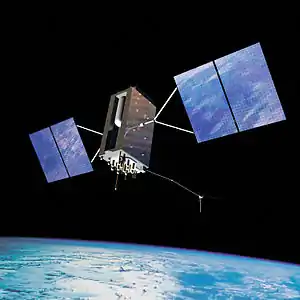 Artist's rendering of GPS-III SV01 in Space. | |
| Names | Navstar 77 GPS-III SV01 Vespucci |
|---|---|
| Mission type | Navigation |
| Operator | USAF |
| COSPAR ID | 2018-109A [1] |
| SATCAT no. | 43873 |
| Mission duration | 15 years (planned) |
| Spacecraft properties | |
| Spacecraft | GPS-III SV01 |
| Spacecraft type | GPS Block III |
| Manufacturer | Lockheed Martin |
| Launch mass | 4400 kg |
| Start of mission | |
| Launch date | 23 December 2018, 13:51 UTC |
| Rocket | Falcon 9 B1054 |
| Launch site | Cape Canaveral, SLC-40 |
| Contractor | SpaceX |
| Orbital parameters | |
| Reference system | Geocentric orbit |
| Regime | Medium Earth orbit (Semi-synchronous orbit) |
| Perigee altitude | 20,118 km (12,501 mi) |
| Apogee altitude | 20,196 km (12,549 mi) |
| Inclination | 55.00° |
| Period | 716.7 minutes |
USA-289, also known as GPS-III SV01 or Vespucci, is a United States navigation satellite which forms part of the Global Positioning System. It was the first GPS Block III satellite to be launched.[2]
Satellite
SV01 is the first GPS Block III satellite to be launched. Ordered in 2008 and originally intended to be launched in 2014, numerous technical delays pushed launch back to 2018.[3]
The spacecraft is built on the Lockheed Martin A2100 satellite bus, and weighs in at 4,400kg (9,700lbs), making SV01 the heaviest GPS satellite ever launched.[4]
Launch
USA-289 was launched by SpaceX on 23 December 2018 at 13:51 UTC atop expendable Falcon 9 booster B1054. The launch took place from SLC-40 of the Cape Canaveral Air Force Station, and placed USA-289 directly into semi-synchronous orbit.
Orbit
As of 2021, USA-289 was in a 55-degree inclination orbit with a perigee of 20,158 kilometers (12,525 miles) and an apogee of 20,222 kilometers (12,565 miles).[5] The satellite is the first GPS satellite to be able to broadcast the civilian L1C signal.[6]
.jpg.webp)
References
- ↑ "Navstar 77". NASA. 14 May 2020. Retrieved 26 September 2020.
 This article incorporates text from this source, which is in the public domain.
This article incorporates text from this source, which is in the public domain. - ↑ "GPS III Space Vehicle No. 1 "Vespucci" Arrives in Florida". Los Angeles Air Force Base. Retrieved 19 December 2019.
 This article incorporates text from this source, which is in the public domain.
This article incorporates text from this source, which is in the public domain. - ↑ "You are being redirected..." gpsworld.com. Retrieved 23 March 2021.
- ↑ "GPS-3 (Navstar-3)". Gunter's Space Page. Retrieved 23 March 2021.
- ↑ "Technical details for satellite NAVSTAR 77 (USA 289)". N2YO.com - Real Time Satellite Tracking and Predictions. Retrieved 23 March 2021.
- ↑ "Signal, orbit and clock analysis of GPS-III SV01" (PDF). Copernicus.